Interfacial Phenomena at the Interface in the System «Carbon Primary Materials-Water Solutions of Surfactants» for Cement Materials
Abstract
:1. Introduction
2. Materials and Methods
2.1. Raw Materials and Characterization
2.2. CNT Dispersion Methods
2.3. Cementitious Composite Fabrication
2.4. Characterization of Surfactants Aqueous Suspensions
2.5. Characterization of CNT Aqueous Suspensions
2.6. Characterization of Cementitious Composite Based on CNT Aqueous Suspensions
3. Results
3.1. Characterization of Surfactants Aqueous Suspensions
3.2. Characterization of CNT Aqueous Suspensions
3.3. Characterization of Cementitious Composite Based on CNT Aqueous Suspensions
3.3.1. Mortar Past Consistory
3.3.2. Mechanical Properties
4. Conclusions
Author Contributions
Funding
Institutional Review Board Statement
Informed Consent Statement
Data Availability Statement
Acknowledgments
Conflicts of Interest
References
- Korolev, E.V. Nanotechnology in materials science. Analysis of the status and achievements. Ways of development. Stroitel’Nye Mater. 2014, 11, 47–79. [Google Scholar]
- Guryeva, V.A.; Belova, T.K. Properties of cement mortars dispersed-reinforced with modified microfiber. Vestn. Orenb. Gos. Univ. 2015, 13, 124–127. [Google Scholar]
- Shekhovtsova, S.; Vysotskaya, M.; Korolev, E.; Inozemtcev, S. Development of aggregationally and sedimentationally resistant nanosuspension for efficient polymer modified bitumen. IOP Conf. Series Mater. Sci. Eng. 2018, 365, 032008. [Google Scholar] [CrossRef] [Green Version]
- Rocha, V.V.; Ludvig, P.; Constâncio, A.; Trindade, C.; Silva, F. The influence of carbon nanotubes on the fracture energy, flexural and tensile behavior of cement-based composites. Constr. Build. Mater. 2019, 209, 1–8. [Google Scholar] [CrossRef]
- Geraldoa, V.; Sérgio, d.O.; da Silvaa, E.E.; Augusto de Souza Oliveira, C. Synthesis of carbon nanotubes on sand grains for mortar reinforcement. Constr. Build. Mater. 2020, 252, 119044. [Google Scholar] [CrossRef]
- De Volder, M.F.L.; Tawfick, S.H.; Baughman, R.H.; Hart, A.J. Carbon nanotubes: Present and future commercial applications. Science 2013, 339, 535–539. [Google Scholar] [CrossRef] [Green Version]
- Gao, Y.; Jing, H.W.; Du, M.R.; Chen, W.Q. Dispersion of Multi-Walled Carbon Nanotubes Stabilized by Humic Acid in Sustainable Cement Composites. Nanomaterials 2018, 8, 858. [Google Scholar] [CrossRef] [Green Version]
- Lu, L.L.; Ouyang, D. Properties of Cement Mortar and Ultra-High Strength Concrete Incorporating Graphene Oxide Nanosheets. Nanomaterials 2017, 7, 187. [Google Scholar] [CrossRef]
- Meng, L.S.; Leung, C.K.Y.; Li, G.Y. Effect of Multi-Walled Carbon Nanotubes on Mechanical Properties and Durability of Latex Modified Cement Mortar. Key Eng. Mater. 2016, 711, 232–240. [Google Scholar] [CrossRef]
- Stynoski, P.; Mondal, P.; Marsh, C. Effects of silica additives on fracture properties of carbon nanotube and carbon fiber reinforced Portland cement mortar. Cement Concr. Compos. 2015, 55, 232–240. [Google Scholar] [CrossRef]
- Xu, S.; Liu, J.; Li, Q. Mechanical properties and microstructure of multi-walled carbon nanotube-reinforced cement paste. Constr. Build. Mater. 2015, 76, 16–23. [Google Scholar] [CrossRef]
- Bharj, J. Experimental study on compressive strength of cement-CNT composite paste. Indian J. Pure Appl. Phys. 2015, 52, 35–38. [Google Scholar]
- Al-Rub, R.K.A.; Ashour, A.I.; Tyson, B.M. On the aspect ratio effect of multi-walled carbon nanotube reinforcements on the mechanical properties of cementitious nanocomposites. Constr. Build. Mater. 2012, 35, 647–655. [Google Scholar] [CrossRef]
- Li, G.Y.; Wang, P.M.; Zhao, X. Mechanical behavior and microstructure of cement composites incorporating surface-treated multi-walled carbon nanotubes. Carbon 2005, 43, 1239–1245. [Google Scholar] [CrossRef]
- Metaxa, Z.S.; Konsta-Gdoutos, M.S.; Shah, S.P. Mechanical properties and nanostructure of cement-based materials reinforced with carbon nanofibers and polyvinyl alcohol (PVA) microfibers. ACI Spring Conv. 2010, 270, 115–124. [Google Scholar]
- Musso, S.; Tulliani, J.-M.; Ferro, G.; Tagliaferro, A. Influence of carbon nanotubes structure on the mechanical behavior of cement composites. Compos. Sci. Technol. 2009, 69, 1985–1990. [Google Scholar] [CrossRef]
- Sanchez, F.; Sobolev, K. Nanotechnology in Concrete—A Review. Constr. Build. Mater. 2010, 24, 2060–2071. [Google Scholar] [CrossRef]
- He, S.; Qiu, J.; Li, J.; Yang, E.-H. Strain hardening ultra-high performance concrete (SHUHPC) incorporating CNF-coated polyethylene fibers. Cem. Concr. Res. 2017, 98, 50–60. [Google Scholar] [CrossRef]
- Lu, Z.; Yao, J.; Leung, C.K. Using graphene oxide to strengthen the bond between PE fiber and matrix to improve the strain hardening behavior of SHCC. Cem. Concr. Res. 2019, 126, 105899. [Google Scholar] [CrossRef]
- Chen, S.J.; Collins, F.; MacLeod, A.; Pan, Z.; Duan, W.H.; Wang, C. Carbon nanotube—Cement composites: A retrospect. IES J. Part A Civ. Struct. Eng. 2011, 4, 254–265. [Google Scholar] [CrossRef]
- Liew, K.M.; Kai, M.F.; Zhang, L.W. Carbon nanotube reinforced cementitious composites: An overview. Compos. A Appl. Sci. Manuf. 2016, 91, 301–323. [Google Scholar] [CrossRef]
- Rashad, A.M. Effect of carbon nanotubes (CNTs) on the properties of traditional cementitious materials. Constr. Build. Mater. 2017, 153, 81–101. [Google Scholar] [CrossRef]
- Mendoza Reales, O.A.; Dias, R.; Filho, T. A review on the chemical, mechanical and microstructural characterization of carbon nanotubes-cement based composites. Constr. Build. Mater. 2017, 154, 697–710. [Google Scholar] [CrossRef]
- Wang, X.; Rhee, I.; Wang, Y.; Xi, Y. Compressive strength, chloride permeability, and freeze-thaw resistance of MWNT concretes under different chemical treatments. Sci. World J. 2014, 2014, 8. [Google Scholar] [CrossRef]
- Hawreen, A.; Bogas, J.A. Creep, shrinkage and mechanical properties of concrete reinforced with different types of carbon nanotubes. Constr. Build. Mater. 2019, 198, 70–81. [Google Scholar] [CrossRef]
- Wang, Z.; Yu, J.; Li, G.; Zhang, M.; Leung, C.K. Chloride-induced corrosion behavior of steel rebar embedded in hybrid CNTs-OH/polyvinyl alcohol modified concrete. Cem. Concr. Compos. 2019, 100, 120–129. [Google Scholar] [CrossRef]
- Lu, L.; Ouyang, D.; Xu, W. Mechanical properties and durability of ultra-high strength concrete incorporating multi-walled carbon nanotubes. Materials 2016, 9, 419. [Google Scholar] [CrossRef] [Green Version]
- Sobolkina, A.; Mechtcherine, V.; Khavrus, V.; Maier, D.; Mende, M.; Ritschel, M.; Leonhardt, A. Dispersion of carbon nanotubes and its influence on the mechanical properties. Cement Concr. Compos. 2012, 34, 1104–1113. [Google Scholar] [CrossRef]
- Kim, G.M.; Nam, I.W.; Yang, B.J.; Yoon, H.N.; Lee, H.K.; Park, S. Carbon nanotube (CNT) incorporated cementitious composites for functional construction materials: The state of the art. Constr. Build. Mater. 2019, 227, 111244. [Google Scholar] [CrossRef]
- Danoglidis, P.A.; Konsta-Gdoutos, M.S.; Gdoutos, E.E.; Shah, S.P. Strength, energy absorption capability and self-sensing properties of multifunctional carbon nanotube reinforced mortars. Constr. Build. Mater. 2016, 120, 265–274. [Google Scholar] [CrossRef]
- Konsta-Gdoutos, M.S.; Danoglidis, P.A.; Falara, M.G.; Nitodas, S.F. Fresh and mechanical properties, and strain sensing of nanomodified cement mortars: The effects of MWCNT aspect ratio, density and functionalization. Cem. Concr. Compos. 2017, 82, 137–151. [Google Scholar] [CrossRef]
- Zou, B.; Chen, S.J.; Korayem, A.H.; Collins, F.; Wang, C.M.; Duan, W.H. Effect of ultrasonication energy on engineering properties of carbon nanotube reinforced cement pastes. Carbon 2015, 85, 212–220. [Google Scholar] [CrossRef]
- Merlin, F.; Guitouni, H.; Mouhoubia, H.; Mariota, S.; Valléeb, F.; Van Dammea, H. Adsorption and heterocoagulation of nonionic surfactants and latex particles on cement hydrate. J. Colloid Interface Sci. 2005, 281, 1–10. [Google Scholar] [CrossRef]
- Reales, O.A.M.; Pearl, W.C.; Paiva, M.D.M.; Miranda, C.R.; Toledo Filho, R.D. Effect of a commercial dispersion of multi walled carbon nanotubes on the hydration of an oil well cementing paste. Front. Struct. Civ. Eng. 2016, 10, 174–179. [Google Scholar] [CrossRef]
- Realesa, O.A.M.; Carisioa, P.A.; dos Santosa, T.C.; William, C.; Pearl, W.C., Jr.; Toledo Filho, R.D. Effect of pozzolanic micro and nanoparticles as secondary fillers in carbon nanotubes/cement composites. Constr. Build. Mater. 2021, 281, 122603. [Google Scholar] [CrossRef]
- Soloviev, V.G.; Khanin, S.D. Dimensional effects in nanostructures based on regular porous matrices. Izvestiya Rossijskogo Gosudarstvennogo Pedagogicheskogo Universiteta Im. A.I. Gercena. 2004, 43, 84–93. [Google Scholar]
- Henglein, A. Small-particle research: Physicochemical properties of extremely small colloidal metal and semiconductor particles. Chem. Rev. 1989, 89, 1861–1873. [Google Scholar] [CrossRef]
- Zhong, W.L.; Wang, Y.G.; Zhang, P.L.; Qu, B.D. Phenomenological study of the size effect on phase transitions in ferroelectric particles. Phys. Rev. 1994, 50, 698–703. [Google Scholar] [CrossRef] [PubMed]
- Volnyanko, E.N.; Murugov, V.A.; Ermakov, S.F. The effect of adsorption modification on the aggregative stability and surface properties of nanodisperse β-sialone. Vestnik Voronezhskogo gosudarstvennogo universiteta Seriya: Himiya. Biol. Farm. 2007, 2, 17–23. [Google Scholar]
- Fairén-Jiménez, D.; Carrasco-Marín, F.; Djurado, D.; Bley, F.; Ehrburger-Dolle, F.; Moreno-Castilla, C. Surface area and microporosity of carbon aerogels from gas adsorption and small- and wide-angle X-ray scattering measurements. J. Phys. Chem. 2006, 110, 8681. [Google Scholar] [CrossRef]
- Gun’ko, V.M.; Bogatyrev, V.M.; Borysenko, M.V.; Galaburda, M.V.; Sulim, I.Y.; Petrus, L.V.; Korduba, O.M.; Polshin, E.V.; Zaulychnyy, Y.V.; Karpets, M.V.; et al. Morphological, structural and adsorptional features of oxide composites of different origin. Appl. Surf. Sci. 2010, 256, 5263. [Google Scholar] [CrossRef]
- . Leboda, R.; Turov, V.V.; Charmas, B.; Skubiszewska-Zięba, J.; Gun’ko, V.M. Surface properties of mesoporous carbon-silica gel adsorbents. J. Colloid Interface Sci. 2000, 223, 112. [Google Scholar] [CrossRef]
- Gun’ko, V.M.; Turov, V.V.; Zarko, V.I.; Pakhlov, E.M.; Charmas, B.; Skubiszewska-Zięba, J. Influence of structural organization of silicas on interfacial phenomena. Colloids Surf. A Physicochem. Eng. Aspects. 2016, 492, 230. [Google Scholar] [CrossRef]
- Gibbs, J.W. Elementary Principles in Statistical Mechanics, Developed with Especial Reference to the Rational Foundation of Thermodynamics; Yale Bicentennial Publications. XVIII; Charles Scribner’s Sons: New York, NY, USA, 1902; p. 207. [Google Scholar]
- Shishkovsk, B. The Great Soviet Encyclopedia: [In 30 Volumes], 3rd ed.; Prokhorov, A.M., Ed.; Soviet Encyclopedia: Moscow, Russia, 1969; p. 197. [Google Scholar]
- Langmuir, I. Surface Chemistry; American Chemical Society: Washington, DC, USA, 1933; Volume 2, pp. 147–191. [Google Scholar]
- Dutton, D. Fundamental absorption edge in cadmium sulfide. Phys. Rev. 1958, 112, 785–792. [Google Scholar] [CrossRef]
- Frolov, Y.G. Colloidal chemistry course. Surface phenomena and dispersed systems. Mosc. Chem. 1982, 1, 399. [Google Scholar]
- Parveen, S.; Rana, S.; Fangueiro, R.; Paiva, M.C. Characterizing dispersion and long term stability of concentrated carbon nanotube aqueous suspensions for fabricating ductile cementitious composites. Powder Technol. 2017, 307, 1–9. [Google Scholar] [CrossRef]
- Parveen, S.; Rana, S.; Fangueiro, R.; Paiva, M.C. Microstructure and mechanical properties of carbon nanotube reinforced cementitious composites developed using a novel dispersion technique. Cem. Concr. Res. 2015, 73, 215–227. [Google Scholar] [CrossRef]
- Du, H.; Pang, S.D. Dispersion and stability of graphene nanoplatelet in water and its influence on cement composites. Constr. Build. Mater. 2018, 167, 403–413. [Google Scholar] [CrossRef]
- Du, M.; Jing, H.; Gao, Y.; Su, H.; Fang, H. Carbon nanomaterials enhanced cement-based composites: Advances and challenges. Nanotechnol. Rev. 2020, 9, 115–135. [Google Scholar] [CrossRef] [Green Version]
- Abedi, M.; Fangueiro, R.; Camões, A.; Correia, A.G. Evaluation of CNT/GNP’s synergic effects on the Mechanical, Microstructural, and durability properties of a cementitious composite by the novel dispersion method. Constr. Build. Mater. 2020, 260, 120486. [Google Scholar] [CrossRef]
- Kumar, S.; Kolay, P.; Malla, S.; Mishra, S. Effect of multiwalled carbon nanotubes on mechanical strength of cement paste. J. Mater. Civ. Eng. 2012, 24, 84–91. [Google Scholar] [CrossRef]
- Xu, Y.D.; Zeng, J.Q.; Chen, W.; Jin, R.Y.; Li, B.; Pan, Z.H. A holistic review of cement composites reinforced with graphene oxide. Constr. Build. Mater. 2018, 171, 291–302. [Google Scholar] [CrossRef]
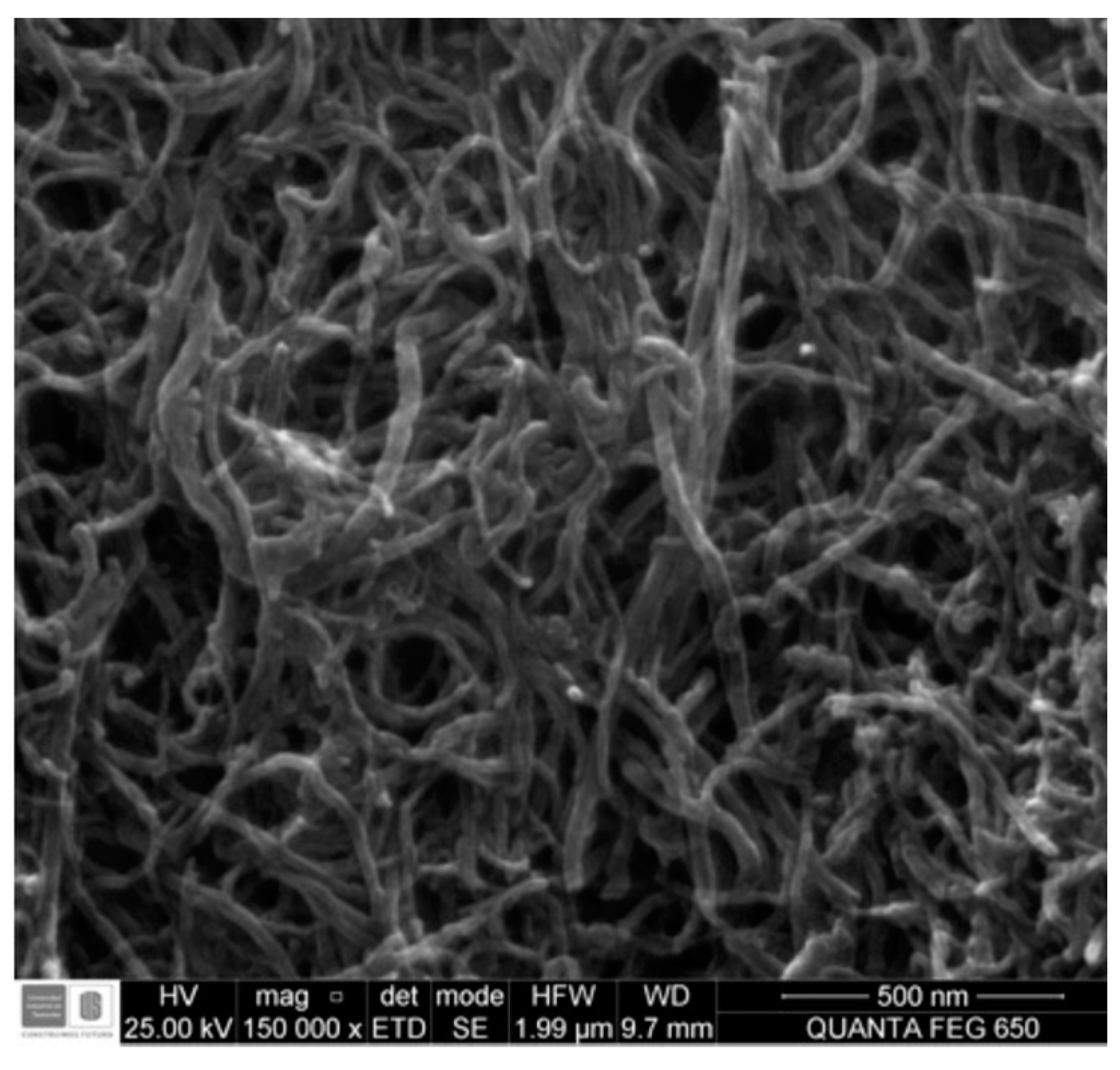
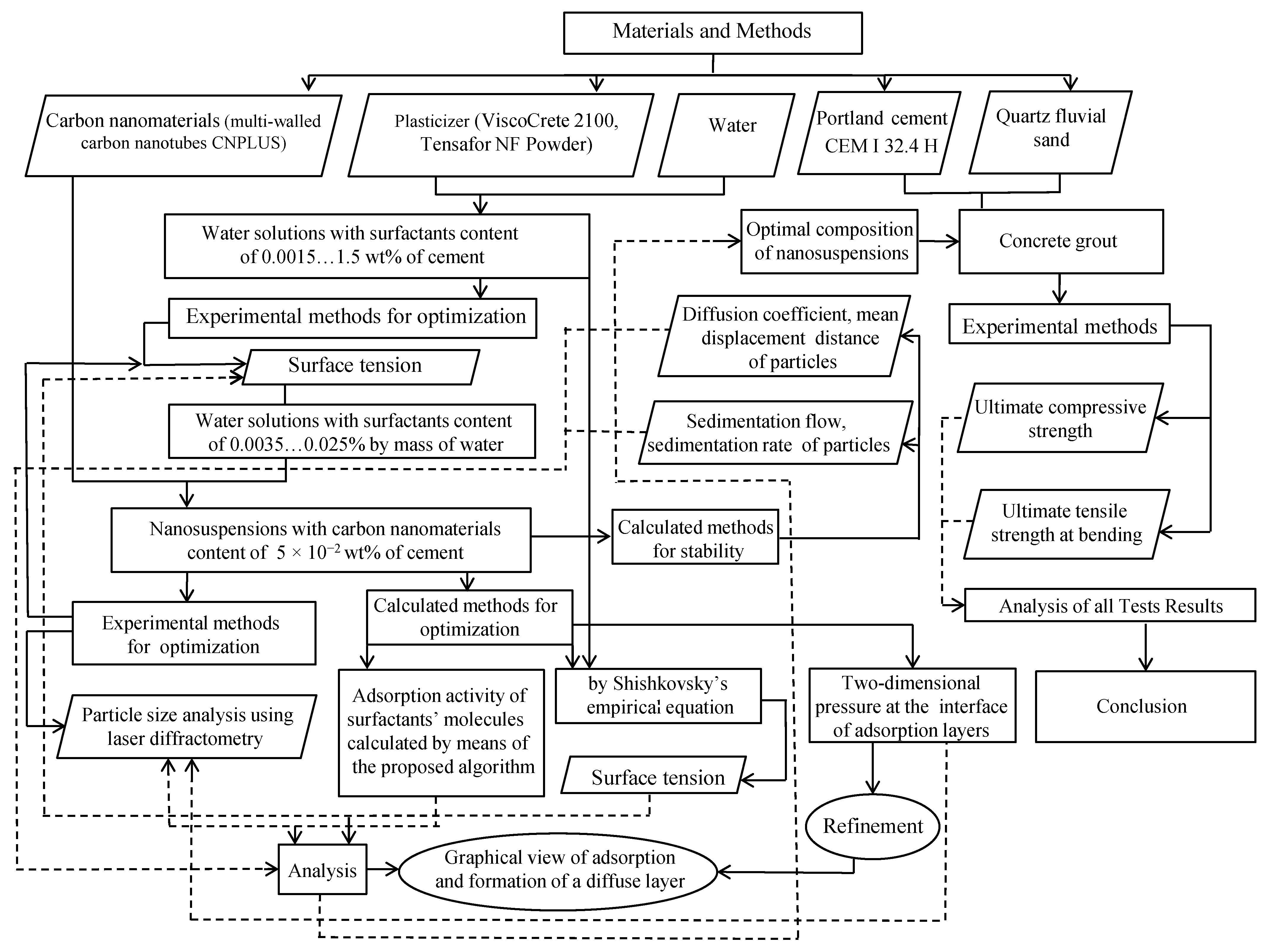

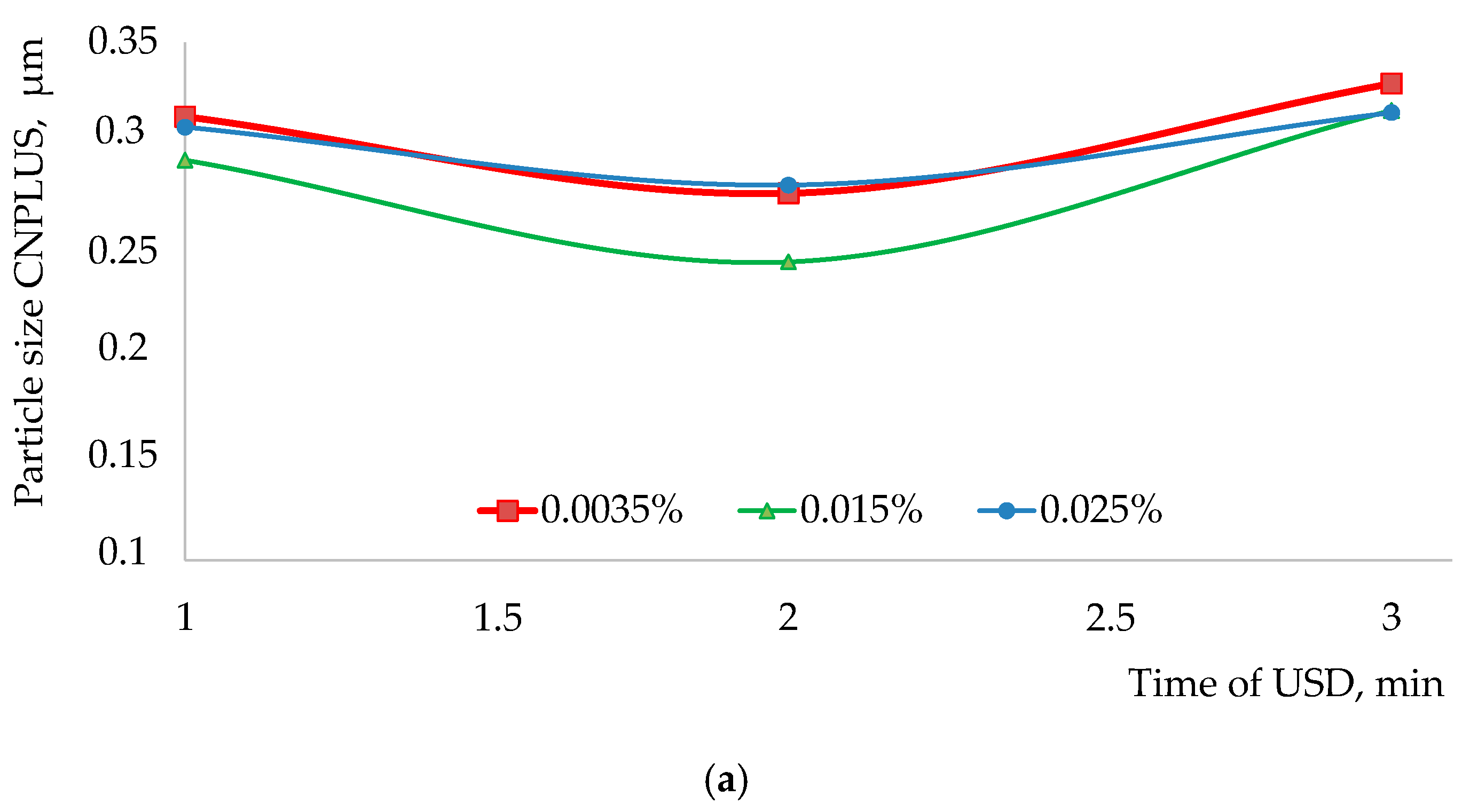

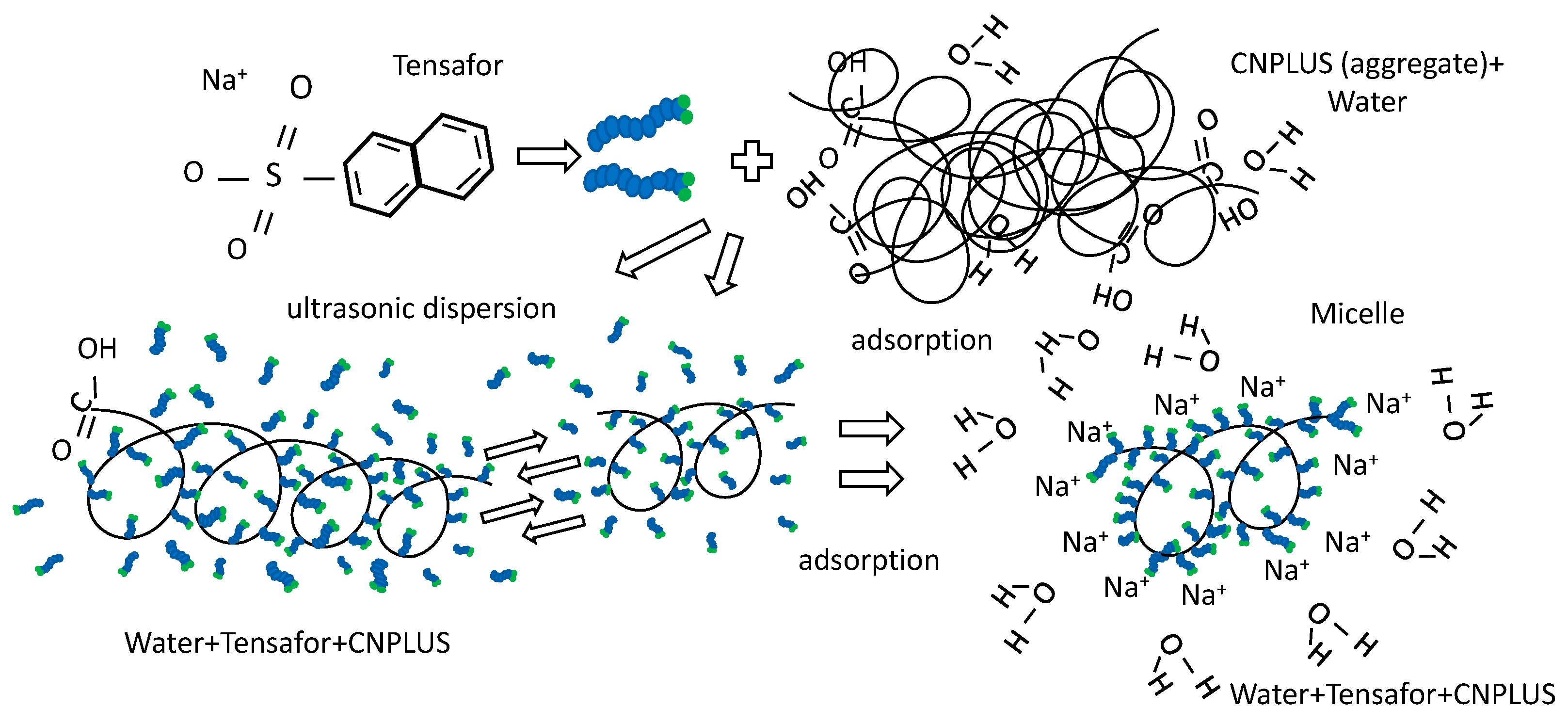




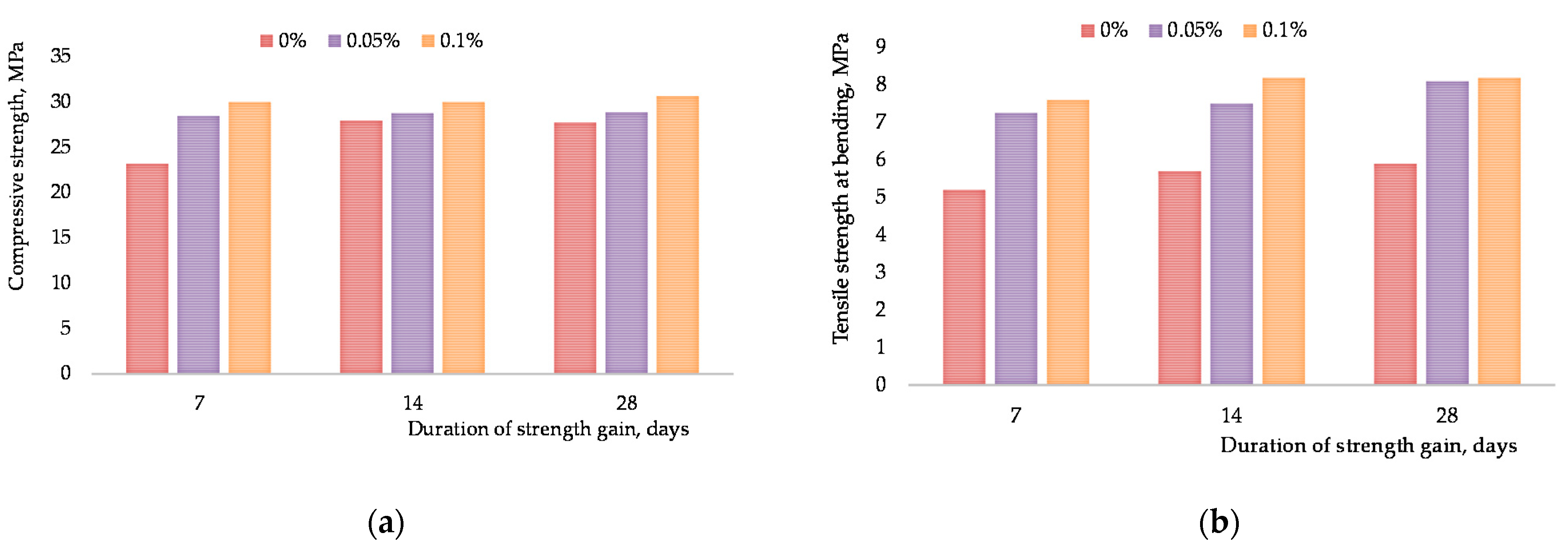
| Property | ViscoCrete 2100 | Tensafor |
|---|---|---|
| pH (Sol. 10%) | 4.5 | 7.0 |
| Solubility (in water), % | - | total hasta 40% |
| Humidity, % Molecular weight, g/mol | – – | 10 max 345.5 |
| Density, g/cm3 | 1.08 | – |
| Property | CNPLUS |
|---|---|
| Specific surface area, m2/g | >110 |
| Density, g/cm3 | 0.14 |
| Color | black |
| Outside Diameter, nm | 10–20 |
| Length, µm | 10–20 |
| Carbon content, % | 98 |
| -OH content, wt% | 2.48 |
| Ash, wt% | <5 |
| Part number | GMC355 |
| Sample ID | CNT, wt% of Cement | Cement, g | W/C Ratio | Sand/Cement Ratio |
|---|---|---|---|---|
| Plain Mortar (V) | 0 | 450 | 0.5 | 3 |
| V (0.05%) | 0.05 | 450 | 0.5 | 3 |
| V (0.1%) | 0.1 | 450 | 0.5 | 3 |
| Plain Mortar (T) | 0 | 450 | 0.45 | 3 |
| T (0.05%) | 0.05 | 450 | 0.45 | 3 |
| T (0.1%) | 0.1 | 450 | 0.45 | 3 |
| Surfactant’s Concentration, % | Experimental Value | Calculated Value | |||
|---|---|---|---|---|---|
| Surface Tension, σ, H/м | Constant | Surface Tension, σ, H/м | Mean-Square Deviation | Variation Coefficient, % | |
| 0 | 71.80 | = 71.8 | 71.80 | 0.000 | 0.00 |
| 0.0035 | 56.28 | B = 2.04 | 56.11 | 0.014 | 0.03 |
| 0.0075 | 53.95 | 54.56 | 0.184 | 0.34 | |
| 0.0150 | 53.57 | A = 1.6 × 10−6 | 53.14 | 0.091 | 0.17 |
| 0.0250 | 51.90 | 52.10 | 0.020 | 0.04 | |
| Surfactant’s Concentration, % | Experimental Value | Calculated Value | |||
|---|---|---|---|---|---|
| Surface Tension, σ, H/м | Constant | Surface Tension, σ, H/м | Mean-Square Deviation | Variation Coefficient, % | |
| 0 | 71.84 | = 71.8 | 71.83 | 0.000 | 0.00 |
| 0.0035 | 52.73 | B =3. 43 | 53.83 | 0.606 | 1.14 |
| 0.0075 | 52.51 | 51.23 | 0.824 | 1.59 | |
| 0.0150 | 49.79 | A = 1.8 × 10−5 | 48.85 | 0.439 | 0.89 |
| 0.0250 | 45.83 | 47.10 | 0.810 | 1.74 | |
| Value of Adsorption at Different Phase Interfaces, mol/m2 | ViscoCrete 2100 | Tensafor |
|---|---|---|
| “aqueous surfactant solution–air”, Γ0, mol/m2 | 73.1470 | 123.0586 |
| “aqueous surfactant solution–air” after the insertion of CNPLUS, Γx, mol/m2 | 73.1409 | 122.0317 |
| “CNPLUS–surfactant” Гf, mol/m2 | 6.3 × 10−3 | 1.026 |
| Parameter | ViscoCrete-2100 | Tensafor |
|---|---|---|
| Two-dimensional pressure at the interface of adsorption layers, J/m2 | 15.6 | 2553.2 |
| Surfactant Type | Duration of Ultrasonic Dispersion, Min | ||||
|---|---|---|---|---|---|
| 1 | 2 | 3 | 4 | 5 | |
| ViscoCrete 2100 | 1.75 × 10−14 1.12 × 10−5 | 3.60 × 10−14 1.61 × 10−5 | 6.97 × 10−14 2.24 × 10−5 | 8.17 × 10−14 2.42 × 10−5 | 8.50 × 10−14 2.47 × 10−5 |
| Tensafor | 2.27 × 10−14 1.28 × 10−5 | 4.51 × 10−14 1.80 × 10−5 | 3.17 × 10−13 4.78 × 10−5 | 1.85 × 10−13 3.65 × 10−5 | 2.00 × 10−13 3.80 × 10−5 |
| Surfactant Type | Duration of the Ultrasonic Dispersion, min | ||||
|---|---|---|---|---|---|
| 1 | 2 | 3 | 4 | 5 | |
| ViscoCrete 2100 | 4.26 × 10−12 2.7 × 10−2 | 4.72 × 10−12 3.00 × 10−2 | 5.11 × 10−12 3.20 × 10−2 | 1.28 × 10−11 8.10 × 10−2 | 3.08 × 10−11 1.94 × 10-1 |
| Tensafor | 2.63 × 10−12 1.7 × 10−2 | 3.57 × 10−12 2.3 × 10−2 | 3.10 × 10−13 2.00 × 10−3 | 3.11 × 10−12 2.0 × 10−2 | 7.14 × 10−12 4.50 × 10−2 |
Publisher’s Note: MDPI stays neutral with regard to jurisdictional claims in published maps and institutional affiliations. |
© 2022 by the authors. Licensee MDPI, Basel, Switzerland. This article is an open access article distributed under the terms and conditions of the Creative Commons Attribution (CC BY) license (https://creativecommons.org/licenses/by/4.0/).
Share and Cite
Shekhovtsova, S.; Korolev, E. Interfacial Phenomena at the Interface in the System «Carbon Primary Materials-Water Solutions of Surfactants» for Cement Materials. Materials 2022, 15, 556. https://doi.org/10.3390/ma15020556
Shekhovtsova S, Korolev E. Interfacial Phenomena at the Interface in the System «Carbon Primary Materials-Water Solutions of Surfactants» for Cement Materials. Materials. 2022; 15(2):556. https://doi.org/10.3390/ma15020556
Chicago/Turabian StyleShekhovtsova, Svetlana, and Evgenii Korolev. 2022. "Interfacial Phenomena at the Interface in the System «Carbon Primary Materials-Water Solutions of Surfactants» for Cement Materials" Materials 15, no. 2: 556. https://doi.org/10.3390/ma15020556






